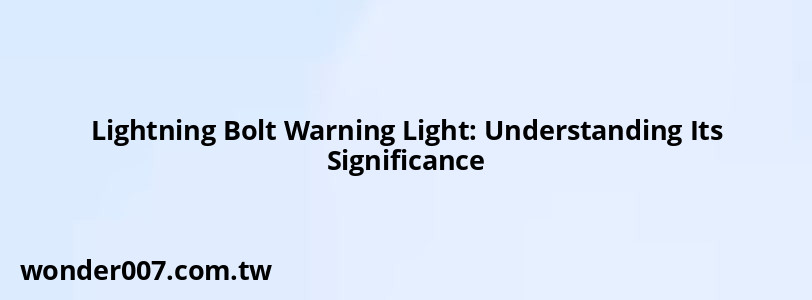Lightning Bolt Warning Light: Understanding Its Significance

The lightning bolt warning light on your vehicle's dashboard is an important indicator that signals potential issues with the electronic throttle control (ETC) system. This warning light often appears in vehicles manufactured by brands like Chrysler, Dodge, and Jeep. Understanding what this light means and how to respond can help ensure your vehicle operates safely and efficiently.
What Does the Lightning Bolt Warning Light Mean?
The lightning bolt symbol typically indicates a malfunction in the electronic throttle control system. This system replaces traditional mechanical linkages with electronic sensors and actuators to manage the engine's throttle opening. When this warning light illuminates, it suggests that there may be problems with one or more components of the throttle control system, which could include:
- Throttle body
- Throttle position sensor
- Accelerator pedal position sensor
- Wiring issues or electrical faults
The severity of the problem can range from minor glitches to significant failures that may affect your vehicle's drivability.
Common Causes of the Warning Light
Several factors can trigger the lightning bolt warning light, including:
- Sensor Malfunctions: Faulty throttle position sensors or accelerator pedal sensors can disrupt communication within the ETC system.
- Wiring Issues: Damaged or corroded wiring can lead to communication failures between components.
- Throttle Body Problems: Dirt buildup or mechanical wear in the throttle body can affect its operation.
- Software Glitches: Occasionally, software issues in the engine control unit (ECU) may cause false readings.
- Battery and Electrical Issues: A weak battery or problems with the alternator can cause voltage fluctuations that impact the ETC system.
Immediate Actions to Take
If you see the lightning bolt warning light, it's crucial to take appropriate steps:
- Check for Other Warning Lights: Look for additional indicators like a check engine light, which may provide further insight into the issue.
- Restart Your Vehicle: Sometimes, turning off and restarting your vehicle can reset the ETC system and clear temporary glitches.
- Drive Cautiously: If the light remains on, avoid high speeds and heavy acceleration. Drive to a safe location or directly to a mechanic.
- Seek Professional Diagnosis: Given the complexity of the ETC system, it's advisable to have a professional inspect your vehicle for accurate diagnosis and repair.
Conclusion
The lightning bolt warning light is a critical alert regarding your vehicle's electronic throttle control system. Ignoring it could lead to serious performance issues or safety hazards. By understanding its implications and taking prompt action, you can help maintain your vehicle's health and ensure a safer driving experience.
FAQs About Lightning Bolt Warning Light
- What should I do if the lightning bolt light comes on?
Check for other warning lights, restart your vehicle, drive cautiously, and seek professional help if necessary. - Can I continue driving with this warning light on?
It is not recommended as it may indicate serious problems that could affect your vehicle’s performance. - What causes this warning light to activate?
Common causes include sensor malfunctions, wiring issues, throttle body problems, software glitches, and electrical issues.
Related Posts
-
Kia Soul Battery Discharge Warning: Causes & Fixes
26-01-2025 • 147 views -
Stanley Fatmax Powerit 1000A: Understanding Warning Lights
26-01-2025 • 218 views -
Master Warning Light: Understanding Your Toyota Highlander
30-01-2025 • 164 views -
Audi Brake Pad Warning Light: What It Means
26-01-2025 • 201 views -
2009 Chevy 5.3 Head Bolt Torque Specifications
29-01-2025 • 128 views
Latest Posts
-
2015 Chevy Traverse AC Recharge Port Location
01-02-2025 • 365 views -
Are O2 Sensors Covered Under Warranty
01-02-2025 • 338 views -
Power Steering Fluid Leak On Passenger Side
01-02-2025 • 419 views -
How To Turn Off Paddle Shifters Mercedes
01-02-2025 • 333 views -
Rear Brake Caliper Piston Won't Compress
01-02-2025 • 312 views
Popular Posts
-
V12 Engine Costs: What You Need to Know
26-01-2025 • 629 views -
EPC Warning Light: What It Means for Your Vehicle
27-01-2025 • 590 views -
Hino Warning Lights: Understanding Dashboard Alerts
26-01-2025 • 632 views -
Power Steering and ABS Light On: Causes and Solutions
27-01-2025 • 610 views -
EPC Light: Understanding Causes and Solutions
26-01-2025 • 1019 views
